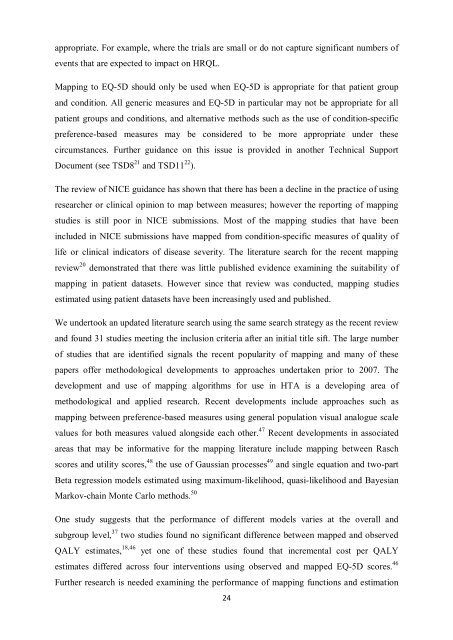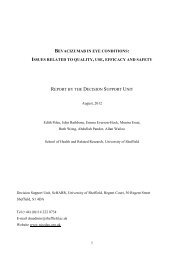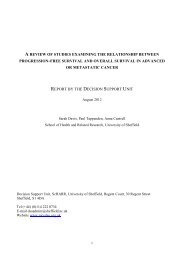the use of mapping methods to estimate health state utility values
the use of mapping methods to estimate health state utility values
the use of mapping methods to estimate health state utility values
Create successful ePaper yourself
Turn your PDF publications into a flip-book with our unique Google optimized e-Paper software.
appropriate. For example, where <strong>the</strong> trials are small or do not capture significant numbers <strong>of</strong><br />
events that are expected <strong>to</strong> impact on HRQL.<br />
Mapping <strong>to</strong> EQ-5D should only be <strong>use</strong>d when EQ-5D is appropriate for that patient group<br />
and condition. All generic measures and EQ-5D in particular may not be appropriate for all<br />
patient groups and conditions, and alternative <strong>methods</strong> such as <strong>the</strong> <strong>use</strong> <strong>of</strong> condition-specific<br />
preference-based measures may be considered <strong>to</strong> be more appropriate under <strong>the</strong>se<br />
circumstances. Fur<strong>the</strong>r guidance on this issue is provided in ano<strong>the</strong>r Technical Support<br />
Document (see TSD8 21 and TSD11 22 ).<br />
The review <strong>of</strong> NICE guidance has shown that <strong>the</strong>re has been a decline in <strong>the</strong> practice <strong>of</strong> using<br />
researcher or clinical opinion <strong>to</strong> map between measures; however <strong>the</strong> reporting <strong>of</strong> <strong>mapping</strong><br />
studies is still poor in NICE submissions. Most <strong>of</strong> <strong>the</strong> <strong>mapping</strong> studies that have been<br />
included in NICE submissions have mapped from condition-specific measures <strong>of</strong> quality <strong>of</strong><br />
life or clinical indica<strong>to</strong>rs <strong>of</strong> disease severity. The literature search for <strong>the</strong> recent <strong>mapping</strong><br />
review 20 demonstrated that <strong>the</strong>re was little published evidence examining <strong>the</strong> suitability <strong>of</strong><br />
<strong>mapping</strong> in patient datasets. However since that review was conducted, <strong>mapping</strong> studies<br />
<strong>estimate</strong>d using patient datasets have been increasingly <strong>use</strong>d and published.<br />
We under<strong>to</strong>ok an updated literature search using <strong>the</strong> same search strategy as <strong>the</strong> recent review<br />
and found 31 studies meeting <strong>the</strong> inclusion criteria after an initial title sift. The large number<br />
<strong>of</strong> studies that are identified signals <strong>the</strong> recent popularity <strong>of</strong> <strong>mapping</strong> and many <strong>of</strong> <strong>the</strong>se<br />
papers <strong>of</strong>fer methodological developments <strong>to</strong> approaches undertaken prior <strong>to</strong> 2007. The<br />
development and <strong>use</strong> <strong>of</strong> <strong>mapping</strong> algorithms for <strong>use</strong> in HTA is a developing area <strong>of</strong><br />
methodological and applied research. Recent developments include approaches such as<br />
<strong>mapping</strong> between preference-based measures using general population visual analogue scale<br />
<strong>values</strong> for both measures valued alongside each o<strong>the</strong>r. 47 Recent developments in associated<br />
areas that may be informative for <strong>the</strong> <strong>mapping</strong> literature include <strong>mapping</strong> between Rasch<br />
scores and <strong>utility</strong> scores, 48 <strong>the</strong> <strong>use</strong> <strong>of</strong> Gaussian processes 49 and single equation and two-part<br />
Beta regression models <strong>estimate</strong>d using maximum-likelihood, quasi-likelihood and Bayesian<br />
Markov-chain Monte Carlo <strong>methods</strong>. 50<br />
One study suggests that <strong>the</strong> performance <strong>of</strong> different models varies at <strong>the</strong> overall and<br />
subgroup level, 37 two studies found no significant difference between mapped and observed<br />
QALY <strong>estimate</strong>s, 18,46 yet one <strong>of</strong> <strong>the</strong>se studies found that incremental cost per QALY<br />
<strong>estimate</strong>s differed across four interventions using observed and mapped EQ-5D scores. 46<br />
Fur<strong>the</strong>r research is needed examining <strong>the</strong> performance <strong>of</strong> <strong>mapping</strong> functions and estimation<br />
24





